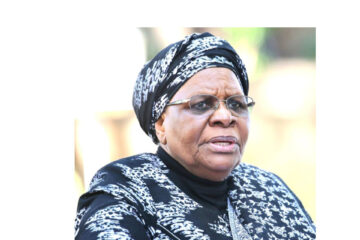Niël Terblanché
The danger level of Crimean Congo Haemorrhagic Fever in Namibia has been reduced after no new cases of the disease were reported over the past four weeks.
Dr Kalumbi Shangula, the Minister of Health and Social Services, announced that the Crimean Congo Haemorrhagic Fever outbreak is officially over following an intensive 28-day surveillance of contacts of a man that passed late in May as a result of the disease.
“A suspected case of Crimean-Congo Haemorrhagic Fever was reported to the Ministry of Health and Social Services on the 17th of May 2023. Unfortunately, the patient succumbed to the disease on 18 May 2023. The case was confirmed by a laboratory on 21st May 2023. The Ministry subsequently declared an outbreak on 22 May 2023,” the minister said.
According to Shangula, Crimean-Congo Haemorrhagic Fever is a severe viral haemorrhagic disease, with a fatality rate of up to 40 percent. It is primarily transmitted to humans through tick bites, handling and crushing of ticks with bare hands or contact with tissues of infected livestock.
Human-to-human transmission can occur through close contact with blood, secretions, organs or bodily fluids of infected persons.
Although Crimean-Congo Haemorrhagic Fever is endemic in Namibia, previous outbreaks have not resulted in secondary cases.
The minister said that currently, there is no vaccine available against Crimean-Congo Haemorrhagic Fever for either humans or animals.
He went on to say that the incubation period for Crimean-Congo Haemorrhagic Fever varies depending on how the virus was acquired. Following infection by a tick bite, the incubation period is usually one to three days, with a maximum of nine days.
In the case of contact with infected blood or tissues, incubation is usually five to six days, with a maximum of 14 days. Crimean-Congo Haemorrhagic Fever transmission is considered interrupted when no new case is identified for a period of 28 days following the last possible exposure which is equal to or double the incubation period.
Shangula said that several public health interventions were implemented to contain the outbreak which included the activation of Health Emergency Management Committees, for Khomas and Omaheke Regions, contact tracing and monitoring of 56 high-risk contacts, the assessment of possible livestock tick infestations to roll out effective tick control measures by veterinary services as well as raising awareness and providing education on proper animal handling at 17 farms in Omaheke Region.
According to Shangula, tick treatment was administered to a total of 4 885 cattle, 1 778 sheep and goats, and 228 horses and donkeys.
The action also entailed the mobilization of development cooperation partners and stakeholders to support the response and preparedness for possible future Crimean-Congo Haemorrhagic Fever outbreaks.
“This included assistance in areas such as laboratory systems, infection prevention and control, risk communication and community engagement, vector control, surveillance, psychosocial support, pharmaceutical supplies, and general logistics,” he said.
Shangula said that the 15th of June 2023 marked the 28th day following the demise of the confirmed case.
“The date is considered the last day of possible exposure. There have been no additional cases of Crimean-Congo Haemorrhagic Fever detected in the country. As a result, I declare the end of the Crimean-Congo Haemorrhagic Fever outbreak in Namibia,” he said.
He lauded the various role players and said that their effort was an act of skill, endurance and ingenuity which deserves acclamation.
The minister expressed gratitude to Crimean-Congo Haemorrhagic Fever Outbreak Response Teams and community members in Omaheke and Khomas Regions, as well as other partners in health for their concerted support to Namibia’s response to the outbreak.
These partners are The Offices of the Governors and Regional Councils in Omaheke and Khomas Regions; the Ministry of Agriculture Water and Land Reform; the World Health Organization (WHO) Country Office; the African Union, through the Africa Centre for Disease Control; the Robert Koch Institute (Germany); the Federal Research Institute for Animal Health (Germany); the United Nations Children’s Fund (UNICEF); the United States Centre for Disease Control and Prevention (CDC); the City of Windhoek and Gobabis Municipality; the Namibia Institute of Pathology (NIP); and all stakeholders who supported the response in one way or the other.
“We count on continued mutual cooperation to protect public health, through timely detection and prompt response to outbreaks,” he said.




